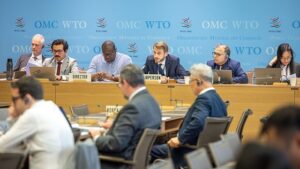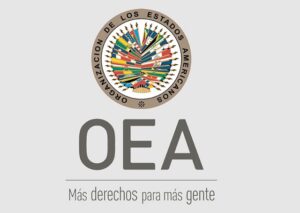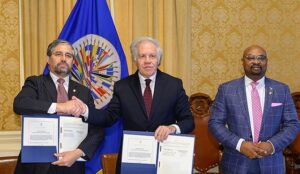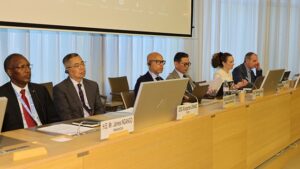DGA González: “La facilitación del comercio y la resiliencia económica son dos caras de la misma moneda”

Durante la pandemia, la facilitación del comercio ha desempeñado un papel de importancia vital para asegurar el comercio de alimentos y otros suministros esenciales, dijo la Directora General Adjunta, Anabel González, en el discurso que pronunció el 1 de febrero en el Foro Mundial 2022 para los Comités Nacionales de Facilitación del Comercio. Señaló la considerable contribución que puede hacer la reforma en materia de facilitación del comercio para ayudar a los países a aprovechar las oportunidades del comercio digital y adaptarse a un entorno comercial en rápida evolución.
(de momento sólo en inglés)
DDG González highlighted the importance of supporting least developed countries (LDCs) in implementing the WTO’s Trade Facilitation Agreement. She said that national trade facilitation committees could bring creative and strategic thinking to help governments, traders and development partners reap the economic benefits from full participation in the global trading system.
The Global Forum brings together members of national trade facilitation committees, policymakers and other relevant stakeholders to discuss the latest trends regarding implementation of trade facilitation reforms, including the implementation of the WTO Trade Facilitation Agreement. DDG González’s remarks are below.
Ladies and gentlemen, dear colleagues, friends:
It’s a real pleasure to join you today. I am pleased that once more, the WTO is part of this important forum.
WTO members have moved solidly into the implementation phase of the WTO Trade Facilitation Agreement and you, the national committees, play a vital role in keeping the positive momentum going.
Efforts to advance trade facilitation must be firmly rooted in the reality of trade in the future, not the past. The pandemic, new technological developments, geopolitical tensions, climate change … all are affecting what we trade, with whom we trade and how we trade. So we must look at what a rapidly changing trade landscape means for the present and future of trade facilitation.
Let me start with the present, which continues to be dominated by the COVID-19 pandemic and its unprecedented health and economic toll.
The pandemic has vividly shown that trade facilitation and economic resilience are two sides of the same coin. Throughout the pandemic, trade facilitation has played a life-saving role in keeping trade in food and other essential supplies flowing. Trade facilitation enabled complex supply chains – some spanning as many as 19 countries – to be stitched together in record time, to provide the specialized inputs and capital goods needed for large-scale production of life-saving COVID-19 vaccines.
We owe all this in no small measures to the adaptability of many border agencies. Under very difficult conditions, many of them took steps to facilitate trade, from simplifying import declarations for essential goods, to accepting scanned copies of certificates, to conducting remote inspections via video.
This is commendable. It’s the kind of flexible, pragmatic and innovative thinking that’s needed not only to respond to an unprecedented health and economic crisis, but also to build back better from it and to boost resilience to future emergencies.
Turning to the future, this century is digital, and trade facilitation will be at the heart of efforts to harness the potential of digital trade.
E-commerce has opened the door to global trade for millions of small businesses all over the world, including many owned by women. And social distancing, lockdowns and other measures adopted to combat the pandemic have led consumers to ramp up online shopping, with global e-retail revenues projected to grow to 5.4 trillion US dollars in 2022.
The opportunities are huge, and so are the challenges. Take the so-called «parcelization» of trade. As the number of cross-border online B2C transactions increases, their average value is decreasing, generating more frequent international flows of lighter and cheaper parcels. That trend poses big challenges for border agencies, whose clearance systems are often designed to tackle large container shipments, not small parcels. The increase in volume of shipments is sure to stretch border agencies around the world, especially in places where infrastructure is outdated, and may heighten the risk of illicit trade in the absence of adequate controls.
The Trade Facilitation Agreement is a powerful instrument to help meet the challenges and seize the opportunities of digital trade. It promotes closer consultation with supply chain participants and greater border agency cooperation with third countries. And it supports the use of risk management, post-clearance audit and authorized operator programs, which can help customs and other border agencies to achieve better balance between their facilitation and security functions. The importance of these tools is especially apparent now when the movement of life-saving medical goods is extremely urgent, but allowing the importation of fraudulent goods can have deadly consequences.
We must also pay greater attention to the contribution of new technologies to trade facilitation reform. Border agencies in many parts of the world are already experimenting with projects and proof-of-concepts involving blockchain, artificial intelligence, the internet of things and more. None of these are silver bullets, but with careful preparation, training and the right enabling environment, they can help border agencies cope better with their expanding responsibilities, and bring tangible improvements in many trade facilitation areas, from single window interconnectivity, to risk management, to the fight against smuggling.
Before I conclude, let me say a few words about implementation of the WTO Trade Facilitation Agreement. Based on WTO notifications, developing countries have committed to implement over 74% of the TFA provisions as of today. This is good news and it owes much to the hard work and commitment of NTFCs. You should be commended for it.
But our job is far from done. LDCs are currently implementing the TFA at a rate of 41%. We need to do better. Development partners, international agencies and NGOs must work alongside LDCs and each other to build capacity, improve connectivity and strengthen trade-related infrastructure.
As members of your NTFC, your role in implementation and trade facilitation reform has become all the more vital. Through your leadership you can encourage border agencies to formalize and build on the facilitating measures that were put in place during the pandemic.
Your role to make sure that border agencies and stakeholders are collaborating and sharing information is essential in this rapidly changing environment.
And you have an important role in making sure that all agencies are seeking and finding the implementation support they need from development partners; that they are on track to meet the implementation dates notified under the TFA; and if not, that requests for extension are filled according to the Agreement’s deadlines.
In conclusion, National Committees will play an even more important role in the years ahead. In addition to your coordination and oversight roles, you can bring creative and strategic thinking to help your government, traders and development partners meet the challenges of the 21st century and reap the economic benefits from full participation in the global trading system.
So let’s keep working together to ensure that trade facilitation becomes an even greater force for good, now and in the years and decades to come. I count on your support.
Thank you.
















